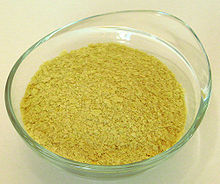Have you ever run across a recipe calling for nutritional yeast and you didn't have any? Maybe didn't even have access to some? Or maybe you attempted to make a batch of bread and the yeast wasn't working anymore?
Too bad I didn't know, a month ago, what I'm about to tell you. I threw away an entire pound package of baking yeast (Saccharoymyces cerevisiae) because it wasn't raising my dough. Sad.
First of all, what IS nutritional yeast? It's deactivated yeast, frequently the strain used is Saccharomyces cerevisiae. Totally dead yeast. Usually it is cultured in something sweet for a few days, then heated to deactivate it. It adds a nutty, savory, almost meat-y depth of flavor to recipes. (The term is 'umami'). It also contains B vitamins and is a complete protein.
I've been studying a new (to me) breadmaking book (more on that later!), and in it, the author, Peter Reinhart, gives instructions for making your own nutritional yeast:
Put 1/4 c. active dry yeast in a hot skillet. Toast over med-hi heat until it turns a medium shade of brown.
That's it.
Now, was my dysfunctional pound of yeast ready to be used as nutritional yeast without toasting? No. It was only partly dead. Or maybe 'mostly dead', to quote a favorite movie. But it needs to be totally dead before you consume it. Besides that, toasting brings out flavor.
Ways to use nutritional yeast:
- as a topping on popcorn
- sprinkle on top of things in place of cheese
- mix into mashed potatoes or scrambled eggs in place of cheese
- add to soups or white sauces to improve flavor (the flavor acts similar to adding bouillon or broth)
- use in this recipe for dairy-free buttery spread
- sprinkle on top of homemade crackers or breadsticks before baking
- make your own vegetable broth recipe, on this post. Tastes like chicken. :)

 RSS Feed
RSS Feed